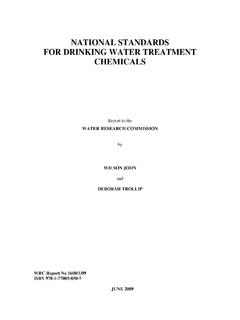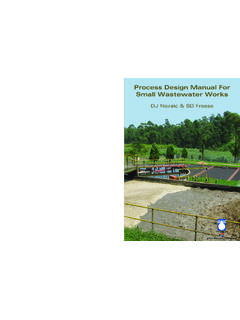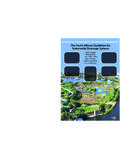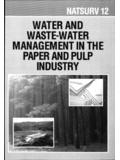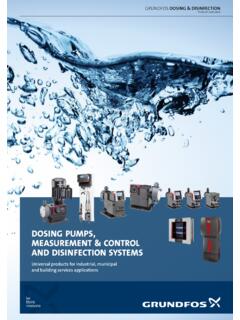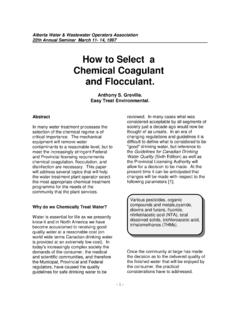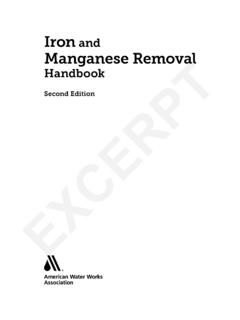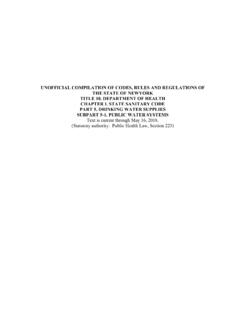Transcription of HANDBOOK FOR THE OPERATION OF - Water Research …
1 HANDBOOK FOR THE OPERATION OF Water treatment WORKS The Water Research Commission The Water Institute of Southern Africa Editor: Frik Schutte Water Utilisation Division Department of Chemical Engineering University of Pretoria TT 265/06 MARCH 2006 Obtainable from: Water Research Commission Private Bag X03 Gezina 0031 The publication of this report emanates from a project entitled: Development of a HANDBOOK for the OPERATION of Water treatment works (Consultancy No 559) DISCLAIMER This report has been reviewed by the Water Research Commission (WRC) and approved for publication. Approval does not signify that the contents necessarily reflect the views and policies of the WRC, nor does mention of trade names or commercial products constitute endorsement or recommendation for use.
2 ISBN 1-77005-428-6 Printed in the Republic of South Africa Cover photographs courtesy of Rietvlei Water treatment Works iiiTABLE OF CONTENTS PURPOSE OF THE HANDBOOK ..1 WHO SHOULD USE THE HANDBOOK ..2 PART A: BACKGROUND 1. Introduction to Water quality and treatment .. 3 2. Drinking Water 25 3. Introduction to Water 38 4. Water treatment calculations .. 58 PART B: treatment PROCESSES 1. coagulation - flocculation .. 70 2. Sedimentation and 87 3. Sand filtration .. 98 4. Disinfection .. 117 5. Chemical stabilisation .. 145 6. Fluoridation .. 158 7. Residuals handling and 164 8. Advanced 172 PART C: MANAGEMENT AND CONTROL 1. General management concepts .. 193 2. treatment plant control .. 200 3. Maintenance and trouble 219 4.
3 Safety .. 227 PART D: APPENDICES AND REFERENCES References .. 232 iv 1 PURPOSE OF THE HANDBOOK The treatment and supply of drinking Water is a challenging task that includes many diverse aspects ranging from Water quality management in catchments, OPERATION and control of Water treatment plants, distribution of treated Water , community participation, project management, etc. The purpose of this HANDBOOK is to provide comprehensive information specifically on all aspects related to the treatment of Water for domestic use. The focus is on the operational aspects of treatment plants and processes and not on process design. Sufficient background and process descriptions are provided to enable a proper understanding of the functioning of the different processes and on aspects such as the suitability of processes for different types of Water and the limitations of different processes.
4 The purpose of this HANDBOOK is not to provide an instruction manual or task list for process controllers or operators to operate unit processes or a treatment plant. A HANDBOOK in the form of an illustrated operational guide is being prepared for the WRC for this purpose. The objective of this HANDBOOK is to provide the plant supervisor and process controller with sufficient knowledge and insight to: Assess raw Water quality as well as the quality of Water from individual unit processes and the treatment plant as a whole to ensure that final Water of the required quality is produced Understand the implications to consumers and other stakeholders if sub-standard Water is produced and supplied Calculate and make adjustments to dosages and operating parameters in response to changes in raw Water quality or other requirements Assess the performance of unit processes and the plant as a whole Identify potential causes of poor performance of unit processes Optimise the performance of unit processes and the plant as a whole Perform basic management tasks including Water loss
5 Assessment and control and safety management The authors recognise that the majority of plant operators currently in operating positions might find the level of material in this HANDBOOK too advanced and would encourage them to use the illustrated HANDBOOK mentioned above. However, the authors feel that wherever possible plant operators should be encouraged to improve their knowledge and qualifications and this HANDBOOK should be useful for that purpose. The layout of this HANDBOOK is such that some aspects are repeated in different sections. Many aspects covered in Part A ( in Overview of treatment Processes and in Water Chemistry) are discussed again in Part B ( treatment Processes).
6 This duplication is beneficial to the reader since the focus of the different sections is different and the same material is presented from different perspectives. 2 This is a first attempt at developing a HANDBOOK specifically for the OPERATION of drinking Water treatment plants to match the HANDBOOK for the OPERATION of Wastewater treatment Works. The initiatives of the Water Research Commission (WRC) and the Water Institute of Southern Africa (WISA) are recognised to have the HANDBOOK developed. Some sections in this HANDBOOK are similar to certain sections in the Wastewater HANDBOOK because the subject material of the basic aspects is very similar. A number of reference books has been used in the compilation of the subject material and they are listed in the reference section.
7 The study material has been compiled by experts in the field with many years of experience in the field of drinking Water treatment . However, it is recognised that the HANDBOOK may have shortcomings from the perspective of process controllers and operators who may have specific requirements not adequately addressed by the book. For this reason HANDBOOK users are requested to submit any suggestions for improvement of future editions to the Water Research Commission or WISA or any of the authors. WHO SHOULD USE THE HANDBOOK ? The level of presentation in this HANDBOOK is on the BSc. and BTech. level, suitable for training of process controllers and treatment plant operators at tertiary training level.
8 Some parts of the HANDBOOK will be useful for in-house training of treatment plant operators and process controllers. The HANDBOOK provides basic information on Water treatment processes and Water supply that should also be useful for other people involved in Water treatment and Water supply, including engineers and scientists. The groups who may find the HANDBOOK useful include: Water treatment plant supervisors and managers Water treatment plant process controllers Engineers and scientists involved in Water treatment and supply Educators and students 3 PART A: BACKGROUND CHAPTER A1: INTRODUCTION TO Water QUALITY AND treatment Frik Schutte INTRODUCTION The term Water quality describes the physical, chemical and microbiological characteristics of Water .
9 These properties collectively determine the overall Water quality and the fitness of the Water for a specific use. These properties are either intrinsic to the Water or are the result of substances that are dissolved or suspended in the Water . Water quality is only meaningful when evaluated in relation to the use of the Water . The reason is that Water of a certain quality may be fit for a specific use, but completely unfit for another use. For example, Water that is fit for human consumption may not be fit as boiler feed Water because the dissolved inorganic salts that are acceptable in drinking Water , are not tolerated in boiler feed Water , since they may precipitate and cause blockages in the boiler equipment.
10 Water that is fit for domestic use (drinking Water ) must comply with specific requirements. The most important requirement is that it must be safe to drink. Many raw Water sources contain harmful micro-organisms or other substances in concentrations that make the Water unsafe to drink or in other ways unfit for domestic use. These organisms and substances must be removed from the Water by means of treatment processes to make the Water fit for domestic use. In addition to the requirement that Water must be safe to drink, Water for domestic use must also be aesthetically pleasing (have a clean appearance, taste and odour) and it must furthermore be chemically stable ( it must not cause corrosion or form deposits in pipes or fixtures such as geysers).
